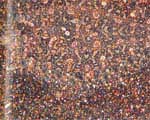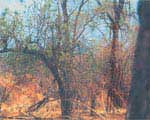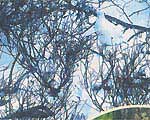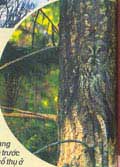Beware! Hidden among the pebbles is a deadly trap! Among the bronze corals, you might strain your eyes but still not see a candy crab. And on the grasslands, the giraffe easily deceives its predators…
 |
|
The flounder camouflaged among the stones. (SVJ) |
Deadly Pebbles
Watch out! Hidden in this pile of pebbles is an extremely dangerous trap: the flounder! You can only see its shadowy outline because, like a chameleon, this fish has a “color palette” in its skin that allows it to blend seamlessly into its surroundings. It is a diabolical weapon. As an ambush expert, it can lie motionless on the bottom of the water for hours. When it spots prey within reach, it darts forward as quickly as a flash of lightning.
 |
|
The candy crab clinging to a branch of pink coral. (SVJ) |
Eating Coral to Look Like Coral
Indeed, everyone admits: Even with keen eyes, it’s hard to spot the candy crab clinging to this bronze coral branch. Only with careful observation can you see the pink creature, striped in red, with its claws grasping the stem. Typically, the crab eats the tiny branches of this soft pink coral to change its color to match.
 |
|
Two “horned dragons” with skin patterns resembling the surrounding rocks and dry leaves. (SVJ) |
Coloring According to the Landscape
In the midst of the scattered rocks and dry leaves, it is not easy to recognize the two “horned dragons.” Their skin is dyed to blend perfectly, using cells filled with different pigments. These cells are surrounded by a muscular ring. When contracted, the color is pushed to the center of the cell and focused at an invisible point. But when relaxed, the color spreads, filling the entire cell. Controlled by the nervous system, these muscular rings “flash” and “turn off,” creating different colors depending on the environment, making them difficult to spot whether in the desert or in the bushes.
 |
|
A giraffe camouflaged among the bushes. (SVJ) |
Invisible Giants
Invisible like a giraffe among the bushes! That may sound strange, but it is true. Look at the picture, where you see spotted patterns. In the context of autumn foliage, with light filtering through the leaves, the giraffe’s spots effectively enhance its “invisibility.” By the time the tigers and lions squint their eyes to discern the figure, the giraffe has already taken off.
 |
|
The feathers of the wild chicken turn snow-white in winter. (SVJ) |
The Winter Coat of the Wild Chicken
The feathers of the wild chicken change with the seasons: brown for the summer, gray for the autumn, and white as snow for the winter.
 |
|
The owl squinting its eyes in front of an ancient tree. (SVJ) |
This small Eurasian owl lives in high mountains, fully adapted to its environment for survival. Just a few weeks after the snow covers the tree trunks, its gray feathers quickly turn to snow white. Without this adaptation, this fragile bird would have been extinct long ago.
Ambush Owl
It is as big as a… goat! But you have to look very closely to spot the Eurasian owl squinting in front of a towering pine tree in the forest. As a nocturnal bird, it remains motionless on the branches during the day. Its gray-white feathers with black circles make it blend seamlessly into the bark of the tree. When it closes its eyes to sleep, it becomes even harder to detect.


















































